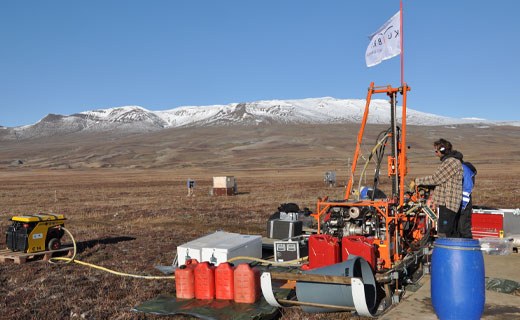Two sides of the same coin – Greenland in a future climate
While the European heat wave dries out the river beds and sets forests on fire, the sea ice at the North Pole is melting, giving the greenhouse effect a further push. But there are indications that permafrost thaws in Greenland are not the biggest culprit when we talk about greenhouse gas emissions. Professor Bo Elberling provides new perspectives on the climate debate after ten years of basic research into permafrost.

“It is a common perception that the Arctic releases greenhouse gases into the atmosphere and that further warming of the Earth makes matters worse. But our research suggests that it is not that simple and that Greenland, for example, does not contribute significantly to the amount of gas in the atmosphere,” says Professor Bo Elberling, who, for the past ten years, has been researching the permafrost thaw’s emissions of greenhouse gases in the interdisciplinary DNRF center CENPERM (Center for Permafrost).
Greenland has it all
“Many previous studies in the area have been based on projects focusing on, for example, one type of vegetation, a few years, and one defined geographical area. So it is absolutely fundamental for us that we have been able to follow the development for more than 10 years, and that we have been able to work both at a molecular level in the laboratory and with experiments out in the landscape in several different climate zones all year round. This means that our research results can give us a more unambiguous picture with greater certainty – across the Arctic landscape.”
“Greenland is ideal for our research, where we have focused on the processes responsible for the uptake and release of greenhouse gases from the ice-free part of Greenland,” Elberling continues, pointing to a large map of Greenland hanging in his office. “There is a humid south, a desertification to the north, and the temperature varies from south to north by 5 to -11 degrees. We have simulated the conditions we imagine there will be in 10, 20, or 50 years, and then we have studied how nature responds to it in 10 different places in Greenland.
A surprising result
“We have been working on the thesis that if it gets warmer, the permafrost will thaw. And then some of the carbon that accumulates in the permafrost will be converted: It will release carbon dioxide and methane, and it will be a process that accelerates itself. The counter-hypothesis is that thawing permafrost, at the same time, means that landscapes are drowning, creating wetlands that protect and bury organic matter. After all, the organic matter buried in the Arctic has just accumulated during periods of a hot and humid climate. So 10 years ago the relevant question was: What will govern whether the Arctic will become a source of greenhouse gas emissions or, conversely, will be a sink for greenhouse gases in the future? The quick answer is water, water, and water.
Elberling continues to explain that wetlands release methane, which is also a worrying greenhouse gas, but when we talk about Greenland, there is much evidence that the dry Northeast Greenland absorbs more methane than the wetlands, which are more widespread in the south. In addition, higher temperatures and more rain will increase plant growth, which both above and below ground will contribute to the accumulation of carbon. So, overall, it’s a series of good news when seen in a climate context.
Elberling adds that the good news does not change the fact that global climate change is real and serious, but we should probably focus on “our own backyard” if we want to make a difference in terms of the greenhouse gas effect. The warming of the Arctic will have many serious consequences for animals and people in the area, but the ice-free part of Greenland will probably not contribute to an increased emission of greenhouse gases, which will have an impact on the content of the atmosphere and thus global climate change.
We put the ship in the lake at the right time
When Elberling closes CENPERM, he will look back on ten valuable years, a large number of publications, and some very important conclusions that hopefully can contribute to an increased understanding and political action in a heated climate debate. “We began our research in this field at just the right time, but now, I see the need for a significant change of tack,” says Elberling, who now wants to concentrate on wetlands from a global perspective: “We know too little about how to manage these in a sustainable way, given that wetlands must both sequester carbon and reduce greenhouse gas release, while contributing to global food security, reducing pollution and reducing flood threats.
When Elberling is asked to give three pieces of advice to a future center manager, he says: “Make sure you have a physical center where everyone can be under the same roof. The daily contact between the researchers and the disciplines is important. Set your team, hire the right people so you get all the features covered. And give your staff space on all fronts and avoid too much top management.”
